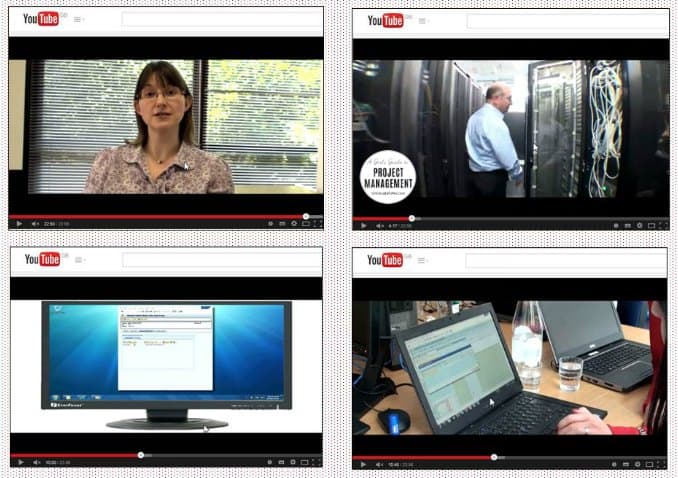15 Practical Tips to Improve Project Communication
This blog is reader-supported. When you purchase something through an affiliate link on this site, I may earn some coffee money. Thanks! Learn more.
Do you want to improve communication on your projects? And yet make it easier to do at the same time?
In this article I’ll share 15 tried-and-tested tips for effective project communications.
1. Use a milestone tracker
The milestone tracker I use is a simple Excel spreadsheet. It lists the milestones in one column, organised by project phase. It also includes the name of the person responsible, the target date and any notes. That’s four columns.
I color-code the date column too, with red, amber and green to show whether the delivery is on track, at risk or needing serious management attention.
When the date has been reached and the milestone achieved, I change it to say Complete. This document is a very simple, yet very effective way of communicating the high-level project dates to stakeholders. And they love it!
Get the project workbook I use here (including the milestone tracker).
2. Use template emails
How many times do you send the same messages to people? The covering emails for the ‘here is the monthly report’ and the ‘please find attached my expenses’ type emails can all be templated.
Either set up templates in your email system or keep a file of template messages. Then copy and paste to save you typing them out.
Get some copy-and-paste email templates for what to say when you are preparing to take a holiday from work.
Communication tip for Outlook users
In Outlook, create your message and save it as a draft. Don’t add any recipients. When you want to use it, click Ctrl+F to ‘forward’ the message.
In Office 2013 and later, you’ll need to open the draft message first. Press Ctrl+F with the cursor inside one of the header fields e.g. where you would put the address.
It will open a new version of the message, and your draft remains in the draft folder until you need to use it again.
Good for:
- Sending out responses to frequently asked questions
- The bare bones of your weekly project status report email, so you only have to fill in the progress
- Messages you send often e.g. invites to project steering group meetings.
3. Use checklists
Create checklists for tasks that you do frequently like hosting Project Board meetings or project kick off. Checklists are in use in hospitals and airlines because they help people remember everything they need to do and ensure nothing gets forgotten.
Pick a few tasks that you struggle with (for me it’s creating POs and then paying the invoices) and create a checklist so you don’t have to think about it anymore.
I also have checklists as a reminder for the daily, weekly, monthly and annual project management tasks I should be doing. That way, at least I always have the basic communication points covered.
Get the checklists I use here.
4. Stand up during phone calls
Have you tried this? It really works! Stand up during your phone calls and you’ll get through the conversation faster.

5. Book meetings now
Get all your face-to-face meetings in the diary now for the year. Stakeholders are busy people so block out their time for your project today.
You can always move meetings or cancel them. People will never complain, in my experience, of having a meeting taken out of their diary! But getting one put in at short notice is difficult and causes stress for organizers and attendees alike.
So book your meetings early.
6. Create a communications asset register
A communications asset register is a list of all the communications assets that you have created for the project. That includes:
- Newsletters
- Press releases
- Internal magazine articles
- Posters
- Flyers and leaflets
- Photos.
Use the register to note the type of asset, when it was created, where it is stored and how it could be reused. Then you’ll always be able to find that elusive picture when you need it!
The register could be as simple as a shared folder on a network or
If you store your register in a public place (and I consider anywhere on the internet to pretty much be public in this day and age), just be careful about the kinds of information that goes in there as many project comms will contain confidential information.
7. Write thank yous
Even if it’s just the tag on a gift — handwriting personal thank yous is a powerful message of appreciation.
I got some lovely notecards from Etsy that I use to thank key stakeholders.
I also got personalized holiday cards made from Moo, and postcards too, which I use if I just want to write a quick note to someone.
8. Use a meeting planner
I use the TimeAndDate.com meeting planner. This is one of my top project team communication tips. If you work with international teams then this is invaluable — you absolutely need to know what time it is where they are.
Think about your international colleagues and how you are going to effectively work with them as you put together your project communication plan.
Try to switch your meetings around from time to time so one team isn’t always the group coming in really early or staying really late.
9. Use email mailing lists
Set up distribution lists for your project. Create one for project team members, Project Board members and any other contacts.
My mailings lists save me a lot of time trying to remember to include everyone. As project management communication tips go, this one is golden!
Communication tip for email mailing lists
Make sure there is more than one person on the team who has access to edit the email list. I’ve had issues on projects before when I needed to get the list changed and the owners was out of the business.
It’s also a good idea to get a BAU owner to take responsibility for the email list. On one project, I was still approving people to join the list six months after the project had closed because there was no one else to take over the management of the list!
Of course, there was, really, but they weren’t aware they had to — it was a project handover task that had been overlooked.
10. Create a communications calendar
When you are thinking about how to improve communication in the project, one of the key things to do is make a plan for it.
Plot out your project communications for the year. When are you doing a newsletter? When are you having a briefing conference call? What are the deadlines for your staff magazine?
If I don’t do this I end up not having enough time to do the communications to a suitable standard (and therefore risk being late or working late). A calendar means I can add the dates to my project plan or diary and never miss a deadline.
There’s a communications calendar inside my project workbook spreadsheet.
11. Book meetings with yourself
This isn’t so much a project communication tip as a way to ensure you do project communications by making time for them.
Diary your repeating events like reporting deadlines. Block time out in your calendar to do these tasks or you’ll find yourself sucked into the daily To Do list and squeezing your reporting into half an hour on Friday afternoon.
12. Automate reports
What reporting can you automate?
I don’t use any systems that enable automated project reporting but if you do have project management software that automatically creates dashboards or can produce bespoke reports at a single click then make sure you know how to use it.
If you can’t properly automate reports, how else can you streamline the production of reports with templates or data feeds to save you time?
13. Piggyback on others
Time your project communications around what other people are doing. This is one of the project management communication strategies I recommend often, especially to program managers!
Talk to your colleagues about what they are sending out to department heads, key stakeholders and workstream leads. No one works in a vacuum. I bet that the subject matter experts doing stuff for you are also working on other projects. Plus, there are normal BAU standard communications that go out regularly.
Tag on to another department’s newsletter and use other teams to get your message out where it makes sense to do so. Find the person who coordinates a broadcast message and work with them to slot your project request, update or whatever into the comms they are already sending.
It’s win win! They get to have extra content in their communication (and in my experience, the people who write internal newsletters love not having to put it all together themselves) and you get your message out without having to create a standalone comms.

14. Update your voicemail
I don’t do this enough — it’s something I need to work on this year. I used to update my voicemail message daily in one of my previous jobs but today I only change it when I’m on leave for more than a day.
It is a good idea to update your voicemail message. It is so easy to do and it gives a very professional impression. Change it as often as sensible, for example to let callers know that you are out all day at a workshop or that you are on vacation.
Just remember to change it back!
15. Get some apps
Install some apps to help you be more productive while you are out and about. Make sure your team can get in contact with you so use tools that they use as well.
There are plenty of collaboration tools to try. Download a few and see if they work for you and your team. If they don’t make you more productive, uninstall them and try something else. Unfortunately, it’s all about trial and error. What works for one project manager won’t work for another.
Bonus Tip: Use video
It works! Use video to communicate short messages. It’s much more personal and you’ll stand out, because I bet other project managers aren’t doing it.

How to improve communication in project management
These 15 tips will help you improve the way you communicate with your team. As a project manager, you should constantly be looking for different ways to track what you do, and make changes to how you communicate.
Keep trying different things until you find tricks, hacks and techniques that work for your team. Then keep them under review! What works today might not be so good in three months.
Keep track of your project communication with my project workbook – the simplest and easiest way to keep control of all the things that are moving on your project. Get your copy here.
